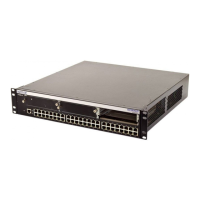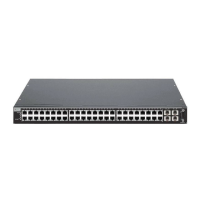Link Aggregation Control Protocol (LACP)
11-46 Port Configuration
Enterasys C3 Usage Considerations
By default, the global LACP state is globally enabled, enabled per port.
In normal usage (and typical implementations) there is no need to modify any of the default
LACP parameters on the switch. The default values will result in the maximum number of
aggregations possible. If the switch is placed in a configuration with its peers not running the
protocol, no dynamic link aggregations will be formed and the switch will function normally (that
is, will block redundant paths). For information about building static aggregations, refer to set
lacp static (page 11-51).
Once underlying physical ports (for example, fe.x.x, or
ge.x.x) are associated with an aggregator
port, the resulting aggregation will be represented as one LAG with a lag.0.x port designation.
LACP determines which underlying physical ports are capable of aggregating by comparing
operational keys. Aggregator ports allow only underlying ports with keys matching theirs to join
their LAG.
LACP uses a system priority value to build a LAG ID, which determines aggregation precedence.
If there are two partner devices competing for the same aggregator, LACP compares the LAG IDs
for each grouping of ports. The LAG with the lower LAG ID is given precedence and will be
allowed to use the aggregator.
There are a few cases in which ports will not aggregate:
• An underlying physical port is attached to another port on this same switch (loopback).
• There is no available aggregator for two or more ports with the same LAG ID. This can
happen if there are simply no available aggregators, or if none of the aggregators have a
matching admin key and system priority.
• 802.1x authentication is enabled using the set eapol command (page 16-18) and ports that
would otherwise aggregate are not 802.1X authorized.
The device with the lowest LAG ID determines which underlying physical ports are allowed into
a LAG based on the ports’ LAG port priority. Ports with the lowest LAG port priority values are
allowed into the LAG and all other speed groupings go into a standby state.
Actor and Partner An actor is the local device sending LACPDUs. Its protocol partner is the
device on the other end of the link aggregation. Each maintains current status
of the other via LACPDUs containing information about their ports’ LACP
status and operational state.
Admin Key Value assigned to aggregator ports and physical ports that are candidates for
joining a LAG. The LACP implementation on Enterasys C3 devices will use
this value to form an oper key and will determine which underlying physical
ports are capable of aggregating by comparing oper keys. Aggregator ports
allow only underlying ports with oper keys matching theirs to join their LAG.
On Enterasys C3 devices, the default admin key value is 32768.
System Priority Value used to build a LAG ID, which determines aggregation precedence. If
there are two partner devices competing for the same aggregator, LACP
compares the LAG IDs for each grouping of ports. The LAG with the lower
LAG ID is given precedence and will be allowed to use the aggregator.
Note: Only one LACP system priority can be set on the Enterasys C3 device,
using either the set lacp asyspri command (page 11-49), or the set port
lacp command (page 11-55).
Table 11-6 LACP Terms and Definitions (Continued)
Term Definition

